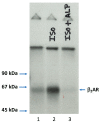Historical Perspective of the G Protein-Coupled Receptor Kinase Family
- PMID: 33806476
- PMCID: PMC7999923
- DOI: 10.3390/cells10030555
Historical Perspective of the G Protein-Coupled Receptor Kinase Family
Abstract
Agonist activation of G protein-coupled receptors promotes sequential interaction of the receptor with heterotrimeric G proteins, G protein-coupled receptor kinases (GRKs), and arrestins. GRKs play a central role in mediating the switch from G protein to arrestin interaction and thereby control processes such as receptor desensitization and trafficking and arrestin-mediated signaling. In this review, I provide a historical perspective on some of the early studies that identified the family of GRKs with a primary focus on the non-visual GRKs. These studies included identification, purification, and cloning of the β-adrenergic receptor kinase in the mid- to late-1980s and subsequent cloning and characterization of additional members of the GRK family. This helped to lay the groundwork for ensuing work focused on understanding the structure and function of these important enzymes.
Keywords: GPCR; GRK; arrestins; phosphorylation; signaling.
Conflict of interest statement
The authors declare no conflict of interest.
Figures


Similar articles
-
Selective recruitment of G protein-coupled receptor kinases (GRKs) controls signaling of the insulin-like growth factor 1 receptor.Proc Natl Acad Sci U S A. 2012 May 1;109(18):7055-60. doi: 10.1073/pnas.1118359109. Epub 2012 Apr 16. Proc Natl Acad Sci U S A. 2012. PMID: 22509025 Free PMC article.
-
G protein-coupled receptor interactions with arrestins and GPCR kinases: The unresolved issue of signal bias.J Biol Chem. 2022 Sep;298(9):102279. doi: 10.1016/j.jbc.2022.102279. Epub 2022 Jul 19. J Biol Chem. 2022. PMID: 35863432 Free PMC article. Review.
-
G-protein-coupled receptor kinase specificity for beta-arrestin recruitment to the beta2-adrenergic receptor revealed by fluorescence resonance energy transfer.J Biol Chem. 2006 Jul 21;281(29):20577-88. doi: 10.1074/jbc.M513605200. Epub 2006 May 10. J Biol Chem. 2006. PMID: 16687412
-
G protein-coupled receptor kinases (GRKs) orchestrate biased agonism at the β2-adrenergic receptor.Sci Signal. 2018 Aug 21;11(544):eaar7084. doi: 10.1126/scisignal.aar7084. Sci Signal. 2018. PMID: 30131371
-
GRKs as Modulators of Neurotransmitter Receptors.Cells. 2020 Dec 31;10(1):52. doi: 10.3390/cells10010052. Cells. 2020. PMID: 33396400 Free PMC article. Review.
Cited by
-
Light induces a rapid increase in cAMP and activates PKA in rod outer segments of the frog retina.J Gen Physiol. 2024 Nov 4;156(11):e202313530. doi: 10.1085/jgp.202313530. Epub 2024 Oct 22. J Gen Physiol. 2024. PMID: 39436404 Free PMC article.
-
G-protein-coupled receptor kinase 4 causes renal angiotensin II type 2 receptor dysfunction by increasing its phosphorylation.Clin Sci (Lond). 2022 Jun 30;136(12):989-1003. doi: 10.1042/CS20220236. Clin Sci (Lond). 2022. PMID: 35695067 Free PMC article.
-
G Protein-Coupled Receptor Kinases Take Central Stage.Cells. 2022 Dec 21;12(1):23. doi: 10.3390/cells12010023. Cells. 2022. PMID: 36611817 Free PMC article.
-
Delineation of G Protein-Coupled Receptor Kinase Phosphorylation Sites within the D1 Dopamine Receptor and Their Roles in Modulating β-Arrestin Binding and Activation.Int J Mol Sci. 2023 Apr 1;24(7):6599. doi: 10.3390/ijms24076599. Int J Mol Sci. 2023. PMID: 37047571 Free PMC article.
-
Discrete GPCR-triggered endocytic modes enable β-arrestins to flexibly regulate cell signaling.Elife. 2022 Oct 17;11:e81563. doi: 10.7554/eLife.81563. Elife. 2022. PMID: 36250629 Free PMC article.
References
Publication types
MeSH terms
Substances
Grants and funding
LinkOut - more resources
Full Text Sources
Other Literature Sources

